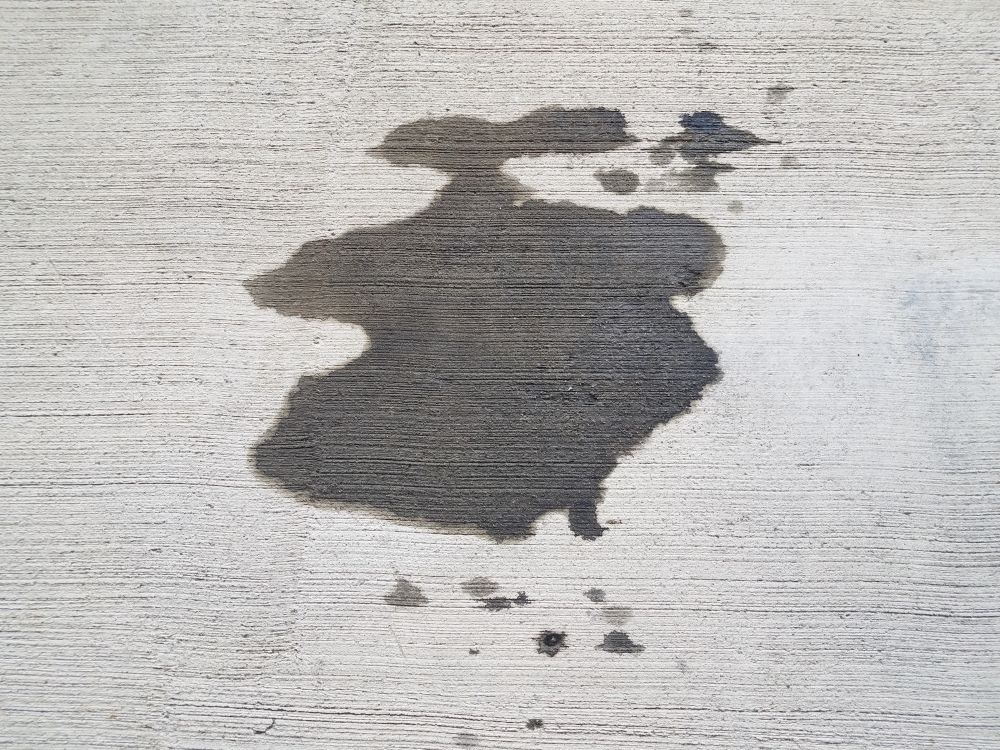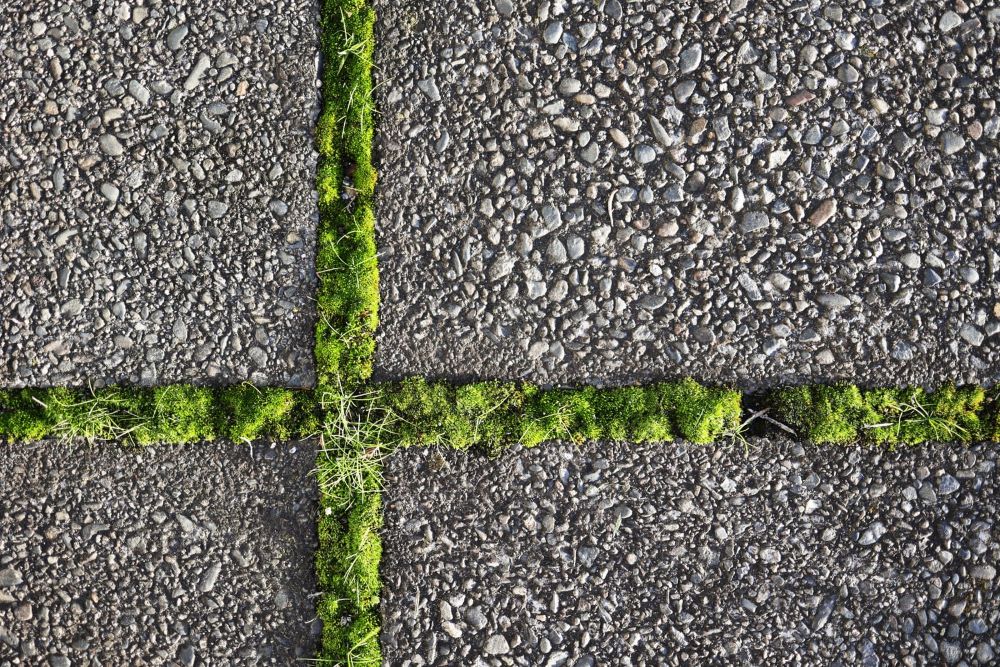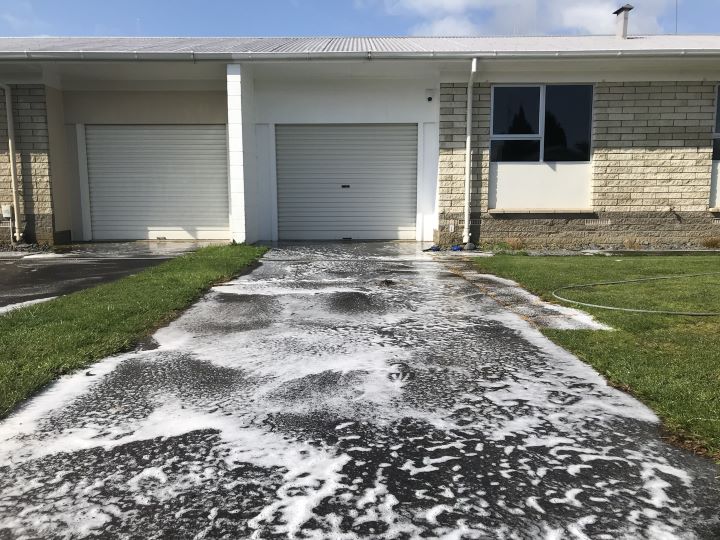One of the first things visitors and bystanders see at your Hamilton home is its driveway, which significantly impacts the curb appeal. Unfortunately, stains that can be ugly and difficult to remove will inevitably form with time.
The clean appearance of your Hamilton driveway can be restored by learning how to remove these four typical driveway stains properly, whether they are caused by mould growth or oil spills from your automobile.
Oil Stains
One of the most infamous offenders is oil stains on driveways, and what gives Hamilton homeowners a headache is their apparent impossibility to remove them. But if you take the appropriate steps, you may lower the visibility of the stain or remove it altogether.
How to Remove Oil Stains
Small Stains
Small, relatively recent oil stains may be easily removed with hot water, detergent, and a steel brush. Apply the detergent, scrub with a steel-bristled brush, wash with water, and repeat as necessary.
Big Stains
You’ll need a degreaser for tough oil stains that are older. These strong, concentrated cleansers effectively remove embedded grime and oil buildup, as well as the majority of vehicle fluids, without causing surface damage. The best part is that they work quickly.
- To clean surfaces that require lighter cleaning, dilute the driveway degreaser with up to five parts water before applying the prescribed amount to the affected area. (The product you use will have the recommended amounts.)
- Wait 1-3 minutes, but for extremely dirty areas, wait a bit longer before washing, but don’t let the product dry fully.
- Use a steel or stiff brush vigorously.
- Leave for 5–10 minutes.
- Rinse with water.
Within 24 hours of washing, any oil mark that has permeated the substrate may resurface; if this happens, repeat the cleaning procedure.
You should follow the product guidelines for the degreasers. The most important thing is to ensure you wear the proper safety gear, including gloves and goggles.
Alternative Solutions for Cleaning Oil Stains From Your Driveway
You may already have a number of ordinary Hamilton household items that might help erase oil stains. Depending on what you have in your home, you might try some of these products or a combination of them to discover which works best on your specific stain.
Cat Litter
Clay-based cat litter can help absorb a recent spill on concrete or asphalt. It might take a few hours to absorb the oils before sweeping and cleaning can start fully.
Fizzy Drink
If there is still residue after applying cat litter, you might try using a few cans of fizzy drinks at room temperature, as this is considered the most optimal. For between 20 minutes and several hours, pour soda on the stain and let it sit before cleaning it away. You may also rub the drink into the stain with a scrub brush or bristle broom.
Baking Soda
Baking soda has chemical characteristics that can aid in the dissolution of oil and filth. The stain may be removed with just the right amount of abrasion without damaging the surface.
Using an absorbent first is useful for baking soda, like kitty litter. After that, scrub it with a paste made of water and baking soda.
Laundry Power
Laundry detergent in powder form can also be useful. Once the oil has spilt, sprinkle it with a mixture made of warm water and clean it for two minutes. 15 minutes later, scrub the area once more, then rinse.
Oven Cleaner
Spray oven cleaner on grease, oil, or transmission stains and wait 10 minutes. Next, scrub it and rinse.
But if you’re cautious about using products with harsh chemicals around your grass and garden beds, you can use a product that is biodegradable; the product will probably indicate this. Also, keep in mind that some stains could require multiple applications.
WD-40
WD-40 can assist you in getting rid of driveway oil streaks in addition to irritating door squeaks. That is because it has ingredients that can pierce grease. It is recommended to liberally mist the area and let it sit for 20 minutes before wiping it clean.

Rust Stains on your Hamilton Driveway
You’ve probably seen the unattractive, brownish-orange stains of metal items, like bikes or garden tools, left on your Hamilton home’s driveway. Metal can rust when left wet, which can spread to your concrete and other surfaces.
How to Remove Rust Stains
Commercial Rust Cleaner for Big or Small Stains
Finding a rust remover with oxalic acid is the best way to see improvement in how your surfaces look. You can also combine trisodium phosphate and water to make hydrochloric acid, which is another acid that works well. If hydrochloric acid is used for an extended period of time, concrete might turn blue; to avoid this, combine two parts of acid with one part of water.
Remember to adhere to any safety instructions listed on the bottle when handling acids. Put on gloves, goggles, and long sleeves on your clothing to cover your skin.
Ensure the surface is clean, apply the acid or rust remover while adhering to the directions and safety warnings on the bottle, and then scrub and rinse. Use a brush appropriate for the job and your surface to prevent damaging your concrete. Use a pressure washer to wash the acid away from particularly difficult stains.
Alternative Methods of Rust Removal
Dish Soap and Water
Starting with the least harmful cleaning method is always a good choice. For surfaces like tiles, concrete, and other porous stones, dish soap works nicely to get out the dirt and grime.
Just treat the surface with a mixture of warm water and dish soap and scrub with a brush. Finally, give it a rinse with fresh water. It may need further cleaning; don’t be afraid to keep going.
White Vinegar
White vinegar is a practical and efficient technique to remove rust stains from outdoor tile and concrete while also being environmentally friendly. Spray it directly onto the stain, then wait less than an hour. Use a stiff-bristle brush to scrub the surface when it has reached the stains.
Always test in a hidden area before you clean concrete or other porous stone to ensure it won’t discolour. To prevent scratches on tiles that were intended to resemble stone, attempt to brush parallel to the original surface. Next, give it a water rinse and let it air dry.
Lemon Juice
Lemon juice is a surprisingly efficient cleaning solution for minor rust spots. Try gently soaking the surface in lemon juice for up to 15 minutes for the greatest benefits, then gently brushing the area in a circular motion. Before using the scrub brush, this enables the lemon juice to remove most of the stains. Finish by running water over the acidic residue to remove it.
Fizzy Drink
Due to their strong acid content, rust stains on your patio can be easily removed by using fizzy drinks. Similar to the white vinegar procedure, pour the carbonated beverage on the stain, allow it to soak for about 15 minutes, and then scrub the area with a scrub brush. Finally, rinse with water.
Detergent
To remove small to medium-sized stains, mix up detergent, baking soda, and cold water until you have a paste. Cover the rust stain with the mixture using a gloved hand or paintbrush, and rub it into the mark. Leave the mixture on the stain for about an hour, then scrub with water and rinse.
WD-40
WD40 can be used to remove rust stains from tile because it is designed to penetrate tile surfaces, even concrete, quickly. Simply spray the rust-damaged area well, and then use a wire scrubber or hard brush to deep clean. You usually don’t need to wait more than a few minutes because WD40 usually works on almost everything right away.
- Mould and Algae
Mould and algae generally grow on shaded portions of Hamilton driveways, patios, and steps that get wet but dry slowly because they don’t get a lot of direct sunlight. Your Hamilton home driveway and pathways could develop, making them slick and risky to walk on.
How to Remove Mould and Algae
Bleach
Bleach is one of the most popular and efficient ways to get rid of black or green mould on concrete. The mould on the concrete will be removed by bleach while also being eliminated from the root.
Put on rubber gloves before you start cleaning. Mix 1/4 cup of liquid bleach in a big bucket with 3 litres of hot water. Always dilute your bleach and manage runoff while rinsing to prevent harm to your lawn or walkways.
Scrub the entire surface with your brush after letting it soak in the solution for a full minute. Before washing it up, let it soak for at least several minutes.
To avoid bleach damage, do not put bleach in your pressure washer, and water your lawn well before cleaning to minimise bleach absorption.
Laundry Detergent
If you’re worried about damage due to bleach, a better alternative for you could be laundry detergent.
Combine one cup of laundry detergent with one gallon of water to make a cleaning solution. The solution should be applied to the floor using a sponge or brush. The detergent will penetrate the concrete’s pores and kill the black mould’s roots.
Make sure the solution permeates the concrete and removes the mould’s roots by using a scrub brush. After finishing, thoroughly clean the concrete with water. When outside, use a hose. Use a mop if inside.
If mould is still present, carry out this procedure once more until the concrete is entirely dry.
White Vinegar
Consider using white vinegar to get rid of black mould if you don’t have any bleach on hand or if you want something more natural and non-toxic for your garden beds and grass. The acid will kill black and green mould in white vinegar. Much like chlorine bleach, vinegar can be used to remove mould in much the same way.
Make a white vinegar solution first by mixing three parts of water with one part of vinegar. Use a mop to apply the solution, and then vigorously scrub the area with a scrub brush. You want the solution to reach the concrete’s pores so it can attack the black mould’s roots there.
Before cleaning the area, allow the solution to soak into the concrete for more challenging mould spots. Use a hose to get rid of the vinegar solution and the loose mould. Reapply the solution and try again if the mould is still present.
Pressure Washing
One of the best tools for removing mould from concrete is a pressure washer. Because you can cover more land in a lot less time than with a mop or scrub, it’s especially useful for treating huge areas, like a wall or an entire driveway.
It also eliminates the need for labour-intensive scrubbing by using high-pressure water instead of your own strength to clear mould. Utilise a pressure washer with a PSI (Pound Per Square Inch) of 1,500 to 2,000. This produces sufficient force to clean concrete without harming it.
Water alone won’t do when using a pressure washer. You’ll need to fill the tank of your pressure washer with mould and mildew concentrate.
Different nozzle types used in pressure washers provide varying pressure levels to the house. Avoid using a high-pressure nozzle, usually coloured red. These high-pressure nozzles are not designed to be used with detergents and can damage the concrete surface.
Use a low-pressure nozzle instead. If the concrete is a wall, spray the wall from bottom to top, working to remove the mould. Sweep the pressure washer back and forth. Streaks on the surface are avoided with this technique.
After letting the cleaner sit on the concrete for about 10 minutes, rinse with a higher-pressure nozzle equipped with a large fan. Rinse the cleaner and mould from the surface using the same waving motion.

Tyre Marks on Your Hamilton Driveway
The rubber compounds in car tyres frequently leave residue on the surface of driveways, which is what causes tyre markings. They can build up over time, especially in areas with a lot of traffic.
How to Remove Tyre Marks From Your Hamilton Driveway
Step 1: Choosing the Correct Product
Prior to beginning, you must select the best cleaning product for the task. You should use a concrete degreaser to remove tyre marks from concrete. You should look for a degreaser that specifically states it can remove tyre marks from concrete.
Step 2: Spot Testing
While all concrete degreasers should be safe to use on your driveway, each driveway varies slightly; therefore, it’s crucial to perform a spot test. Pour a tiny amount of your chosen concrete degreaser onto a hidden area of your driveway while wearing a pair of cleaning gloves to protect your hands. Give the degreaser 15 to 30 minutes to sit. Use a hose or bucket of water to thoroughly rinse the area before carefully inspecting your driveway for any damage.
Step 3: Applying Degreaser to Tyre Marks
Once you’ve established that the concrete degreaser won’t harm your driveway, directly apply a tiny amount of the degreaser to the tyre stains. The degreaser needs to cover the tyre marks thoroughly.
Give the degreaser 15 to 30 minutes to sit. Apply a bit of extra degreaser if it begins to dry out while you wait; it should still be wet when scrubbing. If you are unsure, the instructions on your bottle should give you a detailed outline of what should be done for the best outcome.
Step 4: Scrub
Use a hard-bristle brush to remove the tyre stains from your driveway. Use a wire brush sparingly since it could harm your concrete; you can pick one with stiff plastic bristles instead. Scrub the surface with increasing pressure until the tyre stains are gone. Use a hose or bucket of water to rinse the degreaser off your driveway.
Step 5: Pressure Washing Your Hamilton Driveway
The cleaned portions of your driveway will probably be cleaner than the remainder of your concrete as a result of your hard work. Pressure wash the entirety of your driveway to solve this problem.
Start at the top of the driveway and move the pressure washer’s wand in a back-and-forth motion across the length of the driveway. You should move along your driveway in a back-and-forth motion until the entire area is clear.
Conclusion
Maintaining a spotless and tidy driveway improves the appearance of your Hamilton property and increases its lifespan. By following these tips and techniques, you can effectively remove common stains and keep your driveway looking its best for years to come. Or call a professional exterior house cleaning like Hamilton company DryGutts for quick and easy removal of stains and mess to make your driveway sparkle again.
Take a look at our Beginners Guide article on Spa Pools while you’re here.
